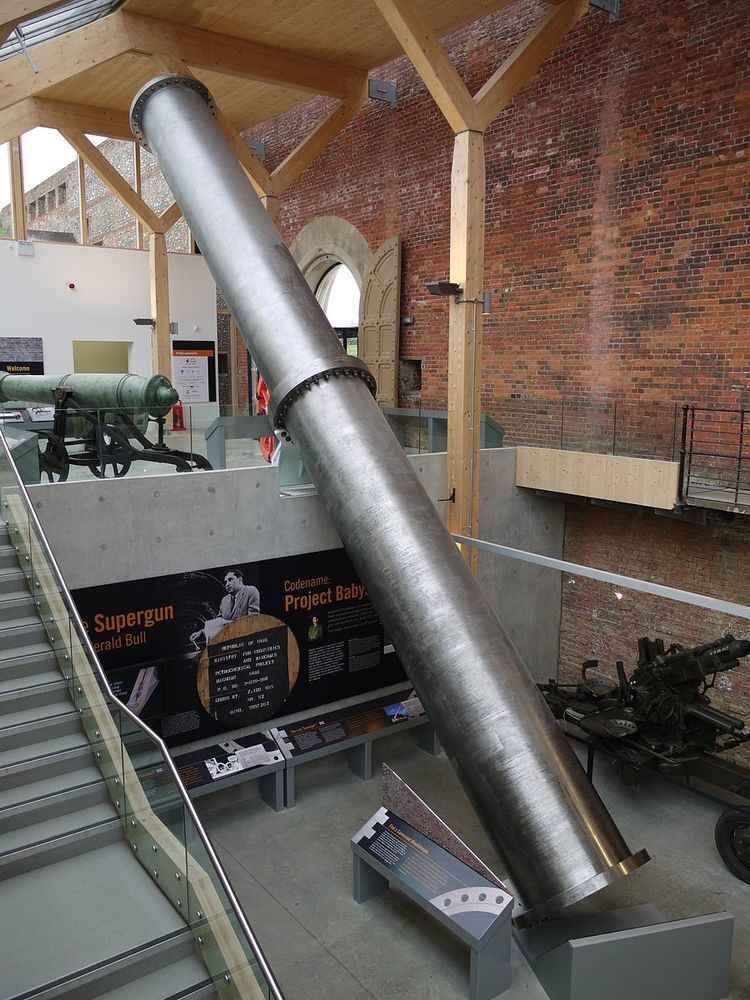 | ||
Project Babylon was a project with unknown objectives commissioned by the then Iraqi president Saddam Hussein to build a series of "superguns". The design was based on research from the 1960s Project HARP led by the Canadian artillery expert Gerald Bull. There were most likely four different devices in the program.
Contents
The project began in 1988; it was halted in 1990 after Bull was assassinated, and parts of the superguns were seized in transit around Europe. The components that remained in Iraq were destroyed by the United Nations, after the 1991 Gulf War.
Baby Babylon
The first of these superguns, "Baby Babylon", was a horizontally mounted device which was simply a prototype for test purposes. It had a bore of 350 mm (13.8 inches), and a barrel length of 46 metres (151 feet), and weighed some 102 tonnes. After conducting tests with lead projectiles, this gun was set up on a hillside at a 45 degree angle. It was expected to achieve a range of 750 km. Although its mass was similar to some World War II German "superguns", it was not designed to be a mobile weapon and therefore it was not considered a security risk by Israel.
Big Babylon
The second supergun, "Big Babylon", of which a pair were planned (one to be mounted horizontally, at least for test purposes), was much larger. The barrel was to be 156 metres (512 feet) long, with a bore of 1 metre (3.3 feet). Originally intended to be suspended by cables from a steel framework, it would have been over 100 metres (300 feet) high at the tip. The complete device weighed about 2,100 tonnes (the barrel alone weighed 1,655 tons). It was a space gun intended to shoot projectiles into orbit, a theme of Bull's work since Project HARP. Neither of these devices could be elevated or trained, making them useless for direct military purposes, unless some form of terminal guidance could be used to direct the fired projectile onto its intended target.
It is possible that Big Babylon was intended both to launch satellites and to serve as a weapon, but its ability to fire conventional projectiles in the latter role would have been very limited: in addition to the impossibility of aiming it, it would have had a slow rate of fire, and its firing would have produced a very pronounced "signature" which would have revealed its location. Since it was immobile, it suffered from the same vulnerability as Germany's V-3 cannon, which the RAF readily destroyed in 1944. Also, Iraq already had Scud missiles which would have been far more effective than the outdated supergun technology. However, the gun would have offered greater ranges than the Scud variants then used by the Iraqis, and its projectiles would have been more difficult to intercept.
Future plans
Very large cannon, which would be capable of being elevated and trained, were also planned. The first was to have a bore of 350 mm (13.8 inches) and a barrel length of about 30 metres (100 feet), and it was expected to have a range of up to 1000 kilometers (about 625 miles), making Israel and central Iran well within reach of Iraqi artillery fire; some sources indicate that there was a second cannon planned, with a bore of 600 mm (23.6 inches) and a barrel length of about 60 metres (200 feet).
Outcome
The metal tubes for the barrels and gun cradles were purchased from firms in the United Kingdom, including Sheffield Forgemasters of South Yorkshire, and Walter Somers of Halesowen. Other components, such as breeches and recoil mechanisms, were ordered from firms in Germany, France, Spain, Switzerland, and Italy. Baby Babylon was completed, and test shots were fired from it, revealing problems with the seals between the barrel segments. However, as those were being worked on, Bull was assassinated in March 1990, possibly by Mossad, halting the project.
Most of the barrel sections for Big Babylon were delivered to, and assembled on, a site excavated from the side of a hill; instead of being suspended by cables from a steel framework as originally planned: calculations had shown that the original support framework would be insufficiently rigid. However, it was never completed.
In early April 1990, United Kingdom customs officers confiscated several pieces of the second Big Babylon barrel, which were disguised as "petrochemical pressure vessels". The parts were confiscated at Teesport Docks. More pieces were seized in Greece and Turkey in transit by truck to Iraq. Other components, such as slide bearings for Big Babylon, were seized at their manufacturers' sites in Spain and Switzerland.
Finally, after the Gulf War in 1991, the Iraqis admitted the existence of Project Babylon, and allowed U.N. inspectors to destroy the hardware in Iraq as part of the disarmament process.
Several barrel sections seized by UK customs officers are displayed at the Royal Armouries, Fort Nelson, Portsmouth. Another section was on display at The Royal Artillery Museum, Woolwich, London, until 2016.
In media
The events of Project Babylon are dramatized in the 1994 HBO movie Doomsday Gun starring Frank Langella as Bull, with Kevin Spacey, Alan Arkin, and Clive Owen in supporting roles.
The supergun of Project Babylon was mocked by the Australian comedy radio show Martin/Molloy as "Saddam's Super Pipes".
